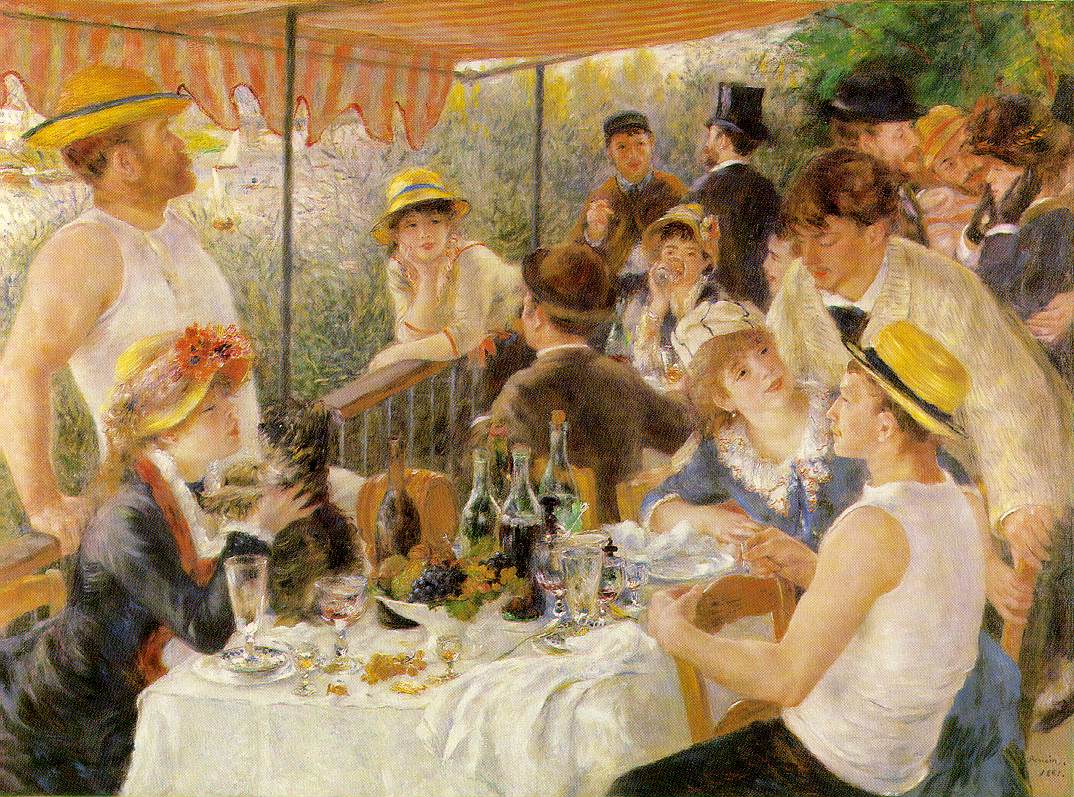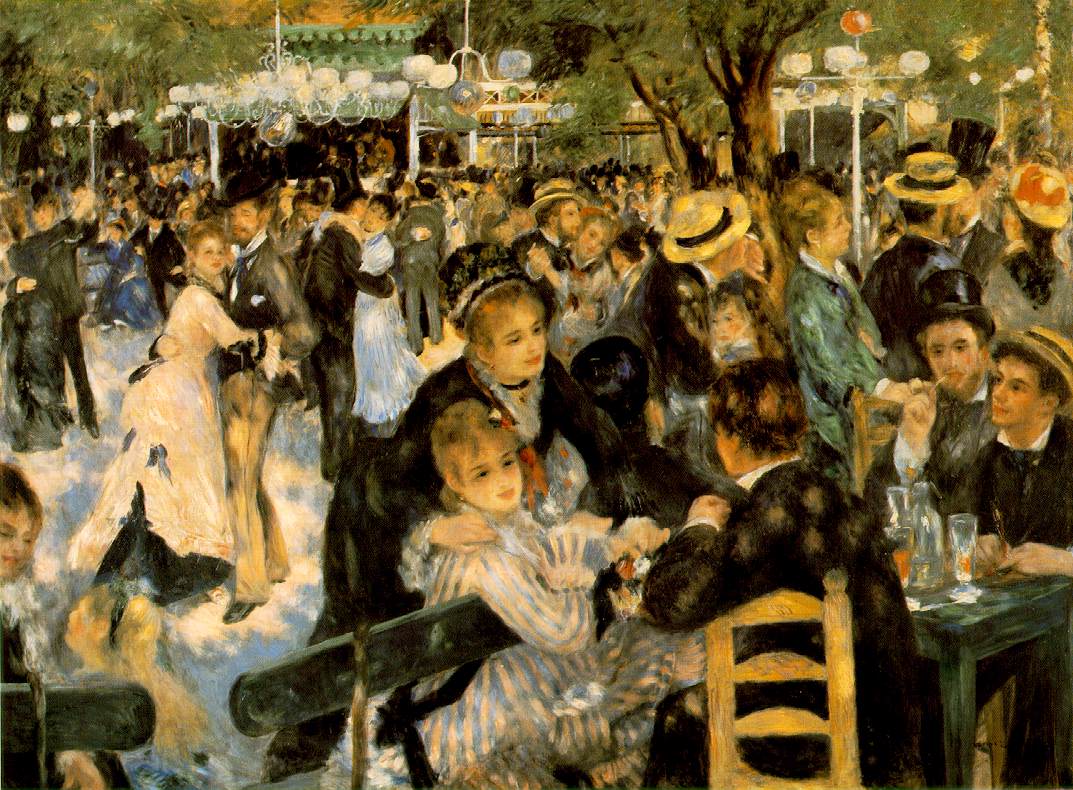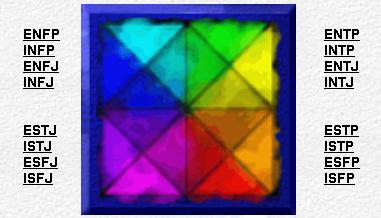S Sensing page
 |
Renoir - Le Dejeuner aux Canotiers http://www.ibiblio.org/wm/paint/auth/renoir/land/dejeuner-canotiers/renoir.dejeuner-canotiers.jpg |
| The Sensing type prefers to take in relevant and practical information about the immediate world around her through the senses. She pays strict attention to details and starts with what she knows from her own experience as she moves step by step into new situations. Sometimes missing the big picture or not being able to read between the lines, the S tends to see things as they appear. Able to live in the moment, the S is acutely observant. She prefers hands on activities to passive endeavors. Other adjectives include: cautious, traditional, hard-working, realistic, curious, pleasure-seeking, uncomplicated, literal-minded, established, routine, sensible, concrete and materialistic. How Ss can strengthen their type: engage more with art: music, literature, visual art, etc. and find personal meaning in the encounter. Enter into discussions with their opposite type, iNtuitives. |
| Details about the MBTI: The Myers-Briggs Type
Indicator (MBTI) is a psychological
test designed to assist a person in identifying their personality
preferences. It was developed by Katherine Briggs and her daughter Isabel Myers
during World War
II, and follows from the theories of Carl Jung as laid out in his work Psychological Types. The
phrase is also a trademark of the publisher of the instrument, Consulting Psychologists
Press Inc., and the trademark is registered by the Myers-Briggs Type Indicator Trust. The test is frequently
used in the areas of pedagogy,
group
dynamics, employee training, leadership training, marriage
counseling, and personal development, although its value has been
questioned by scientific skeptics and some psychologists. About the test
The test differs from standardized tests and others measuring
traits, such as intelligence,
instead identifying preferred types. While types and traits are both inborn, traits can be
improved akin to skills,
whereas types, if supported by a healthy environment, naturally differentiate
over time. The test attempts to tell the order in which this occurs in each person, and it
is that information, combined with interviews done with others who have indicated having
the same preferences, that the complete descriptions are based on. The test then, is akin
to an arrow which attempts to point in the direction of the proper description. The facet
of the theory which posits that the features being tested for are in fact types, and not
traits which can be improved with practice, is hotly debated, lacking definitive proof. The types the MBTI tests for, known as dichotomies, are
extraversion, introversion, sensing, intuition, thinking, feeling, judging and perceiving.
Participants are given one of 16 four-letter acronyms, such as ESTJ or INFP, indicating
what they prefer. The term best-fit types refers to the ethical code that facilitators are
required to follow. It states that the person taking the test is always the best judge of
what their preferences are, and the test itself should never be used to make this
decision. The preferences
A dichotomy is a division of two mutually exclusive groups,
or in this case, type preferences.
Type dynamics
The table organizing the sixteen types was created by
Isabel Myers, who preferred INFP (To find the opposite type of the one you are looking at,
jump over one type diagonally.) By using inferential
statistics an estimate of the preferences found in the US population has been gathered The interaction of two, three, or four preferences are known
as type dynamics, and when dealing with a four-preference combination it is called a type.
In total, there are 16 unique types, and many more possible two and three letter
combinations, which each have their own descriptive name. Additionally, it is sometimes
possible to observe the interactions that each preference combination will have with
another combination, although this is more unorthodox. Complete descriptions will contain
the unique interactions of all four preferences in that person, and these are typically
written by licensed psychologists based on data gathered from thousands of interviews and
studies. The Center for Applications of Psychological Type has released short descriptions
on the internet. The most in-depth descriptions, including statistics, can be found in The
Manual . The type table
The type table is a visualization tool which is useful for
discussing the dynamic qualities and interactions of preference combinations. It will
typically be divided by selecting any pair of preferences and comparing or contrasting.
One of the most common and basic has been used to the right. It is the grouping of the
mental functions, ST, SF, NF and NT, and focuses on the combination of perception and
judgment. Alternatively, if we group by the rows we will have the four attitudes which are
IJ, IP, EP and EJ. There are also more complex groupings, such as combinations of
perception and orientations to the outer world, which are SJ, SP, NP and NJ, or
combinations of judgement and orientations to the outer world, which are TJ, TP, FP, and
FJ. Descriptions of the function-attitudes
In addition to a person's general preference for introversion
or extraversion (attitudes), each function can be introverted or extraverted as
well (function-attitudes), and the same function will have different qualities
depending on its attitude .
Cognitive function dynamics in each type
In each type, all four of the cognitive, or mental functions,
which are sensing, intuition, thinking and feeling, are present and arranged in a
different order. The type acronym is used as a quick way to figure out this order, which
is slightly different in introverts and extroverts. A person is considered 'introverted'
or 'extroverted' depending on their dominant, or first function. An important point to
remember is that the first and last letter of the type are used as guides to figure out
the order of the middle two letters, which are the main priority. The chart below this
section has the dynamics worked out for each type. Introverts
If the first letter of the type is an I, such as in INFP,
then the dominant is introverted. The next step is to figure out which of the middle two
letters this applies to, which is done by looking to the last letter. If it is a P, then
the dominant will be the third letter, which is the judging function (the process is
backwards and slightly confusing for introverts). If it is a J, then it will be the second
letter, which is the perceiving function. Already it is possible to tell that the INFP has
an introverted dominant, and that it is feeling, which is called introverted feeling. Also
evident is that the auxiliary is intuition. A rule of thumb
is that the last three functions are always extraverted in introverts, and introverted in
extraverts, so it is extraverted intuition. The third function of the introverted personality will be the
opposite of the second. For the INFP, the second is extraverted intuition, so the third is
extraverted sensing. The fourth will be the opposite of the first, which ends up as
extraverted thinking. Extroverts
If the first letter of the type is an E, such as ESTJ, then
the dominant is extraverted. The next step, which is slightly different than in
introverts, is to figure out to which of the middle two letters this applies. If the last
letter is a P, then the dominant will be the second letter, and if it is a J, then it will
be the third letter. Thus, we can tell from this that the first or dominant in the ESTJ is
extraverted thinking, and the second is introverted sensing. The third, which is the
opposite of the second, is introverted intuition, and the fourth is introverted feeling. Function table
Controversy surrounding the cognitive functions
Isabel Myers interpreted Jung's writing as saying that the
auxiliary, tertiary, and inferior functions are always in the opposite attitude of the
dominant. Many, however, have found Jung's writing to be ambiguous, and those who study
and follow Jung's theories (Jungians) are typically adamant that Myers is incorrect.
Jungians posit that Jung made explicit the point that the tertiary function is actually in
the same attitude as the dominant, providing balance. More recently, typologists such as
John Beebe and Linda Berens have introduced theoretical systems that include all eight
functions, with the latter four known as the "shadow functions," residing
largely in the unconscious.
In their models, the tertiary is in the same attitude as the dominant. Temperament
Keirsey's four temperaments within the MBTI. Hippocrates, a Greek philosopher who lived from 460-377 B.C., proposed four humours in his writings. These were blood, phlegm, yellow bile and black bile. In 1978, David Keirsey and Marilyn Bates reintroduced temperament theory in modern form and identified them as Guardian, Artisan, Idealist, and Rationalist. After developing modern temperament theory, Keirsey discovered the MBTI, and found that by combining intuition with the judging functions, NT and NF, and sensing with the perceiving functions, SJ and SP, he had descriptions similar to his four temperaments. The Manual states on page 59 that, "It is
important to recognize that temperament theory is not a variant of type theory, nor is
type theory a variant of temperament theory." Keirsey later went on to develop the
Kiersey Temperament Sorter, which was first included in his book Please Understand Me. About the test, scoring and psychometrics
The current test asks 93 forced-choice questions, which means
there are only two options. Participants may skip questions if they feel they are unable
to choose. Using psychometric techniques, such as item
response theory, the test will then be scored and will attempt to identify which
dichotomy the participant prefers. After taking the test, participants are given a readout
of their score, which will include a bar graph and number of how many points they received
on a certain scale. Confusion over the meaning of these numbers often causes them to be
related to trait theory, and people mistakenly believe, for example, that their intuition
is "more developed" than their sensing, or vice versa. During construction of the test, thousands of items are used,
and most are thrown out because they do not have high midpoint discrimination, meaning the
results of that one item do not, on average, move an individual score away from the
midpoint. Using only items with high midpoint discrimination allows the test to have fewer
items on it but still provide as much statistical information as a test with many more
items with lower midpoint discrimination. The test requires five points one way or another
before it is nearly as sure it can statistically be concerning a preference. Ethics
Before purchasing the test, practitioners are required to
consent to an ethical
code, in addition to meeting the educational requirements of class B and C
psychological tests and assessments. After consenting to this code the usage of the
indicator is largely unmonitored, which sometimes leads to abuses of the instrument. The
ethical code contains, but is not limited to, the following points:
Skeptical view
Scientific skeptics such as Robert Todd Carroll, author
of The Skeptic's Dictionary, have presented several
potential problems with the MBTI. The foremost issue is that the way the MBTI is designed
makes it difficult to validate any of the claims it makes about types using scientific
methods. Carroll says, "no matter what your preferences, your behavior will still
sometimes indicate contrasting behavior. Thus, no behavior can ever be used to falsify the
type, and any behavior can be used to verify it." Carroll also notes that the theory of psychological types
created by Carl Jung
was not based on any controlled studies—the only scientific study Jung performed was
in the field of astrology.
Carroll argues that Jung may not even have approved of the MBTI, quoting, "My scheme
of typology is only a scheme of orientation. There is such a factor as introversion, there
is such a factor as extraversion. The classification of individuals means nothing, nothing
at all. It is only the instrumentarium for the practical psychologist to explain for
instance, the husband to a wife or vice versa." Further, Jung's methods primarily included introspection and anecdote, methods largely rejected by the modern field of cognitive psychology. Still others have argued that, while the MBTI may be useful for self-understanding, it is commonly used for pigeonholing people or for self-pigeonholing.(excerpted from Wikipedia --< http:// Myers-Briggs Type Indicator - Wikipedia, the free encyclopedia > |
| Take the test! < http://Online test based on Jung - Myers-Briggs typology > |
 |
| The Sixteen Types ISTJ
ISFJ INFJ INTJ ISTP ISFP INFP INTP ESTP ESFP ENFP ENTP ESTJ ESFJ ENFJ ENTJ |
| From the Source: from the Myers-Briggs foundation <http:// Myers
& Briggs - My MBTI Personality Type - MBTI Basics > The purpose of the
Myers-Briggs Type Indicator® (MBTI) personality
inventory is to make the theory of psychological types described by C. G. Jung
understandable and useful in people’s lives. The essence of the theory is that much
seemingly random variation in the behavior is actually quite orderly and consistent, being
due to basic difference in the way individual prefer to use their perception and judgment. "Perception
involves all the ways of becoming aware of things, people, happenings, or ideas. Judgment
involves all the ways of coming to conclusions about what has been perceived. If people
differ systematically in what they perceive and in how they reach conclusions, then it is
only reasonable for them to differ correspondingly in their interests, reactions, values,
motivations, and skills." In developing the
Myers-Briggs Type Indicator [instrument], the aim of Isabel Briggs Myers, and her mother,
Katharine Briggs, was to make the insights of type theory accessible to individuals and
groups. They addressed the two related goals in the developments and application of the
MBTI instrument: The identification of
basic preferences of each of the four dichotomies specified or implicit in Jung’s
theory. The identification
and description of the 16 distinctive personality types that result from the interactions
among the preferences.” Excerpted with
permission from the MBTI®
Manual: A Guide to the Development and Use of the Myers-Briggs Type Indicator® Favorite
world: Do
you prefer to focus on the outer world or on your own inner world? This is called Extraversion (E) or Introversion (I). Information: Do you prefer to focus
on the basic information you take in or do you prefer to interpret and add meaning? This
is called Sensing (S) or Intuition (N). Decisions: When making decisions,
do you prefer to first look at logic and consistency or first look at the people and
special circumstances? This is called Thinking (T) or Feeling (F). Structure: In dealing with the
outside world, do you prefer to get things decided or do you prefer to stay open to new
information and options? This is called Judging (J) or Perceiving (P). Your
Personality Type: When you decide on
your preference in each category, you have your own personality type, which can be expressed as a
code with four letters. The 16 personality types of the Myers-Briggs
Type Indicator® instrument
are listed here as they are often shown in what is called a “type table.” All types are equal:
The goal of knowing about personality type is to understand and appreciate differences
between people. As all types are equal, there is no best type. The MBTI instrument
sorts for preferences and does not measure trait, ability, or character. The MBTI tool is
different from many other psychological instruments and also different
from other personality tests. The best reason to
choose the MBTI instrument to discover your personality type is that hundreds of studies
over the past 40 years have proven the instrument to be both valid and reliable. In other words, it measures what
it says it does (validity) and produces the same results when given more than once
(reliability.) When you want an accurate profile of your personality type, ask if the
instrument you plan to use has been validated. The theory of psychological type was introduced in the 1920s by Carl G. Jung. The MBTI tool was developed in the 1940s by Isabel Briggs Myers and the original research was done in the 1940s and 50s. This research is ongoing, providing users with updated and new information about psychological type and its applications. Today, more than two million people worldwide take the test every year. |
 |




